-
Nijlvragen
Twee weken geleden werd het nieuws bekend gemaakt dat er een nieuwe tak van de Nijl ontdekt was. De zogenaamde Ahramat (‘piramide’)-tak zou langs 31 piramides lopen, inclusief die van Khufu in Giza. Dit werd geschreven in een nieuwe publicatie door Ghoneim et al. in het wetenschappelijke tijdschrift Communication Earth and Environment van Nature. Deze waterloop ligt nu verborgen onder het landschap en werd met behulp van satellietbeelden, historische kaarten, geofysisch onderzoek en boringen gelokaliseerd.
De ontdekking is belangrijk omdat we zo meer te weten komen over hoe het Oudegyptische landschap eruit zag en hoe de stenen werden aangeleverd voor de bouw van de piramides. Onderaan de vaak lange dalwegen (‘causeways’) van de piramidecomplexen bevinden zich kades waar boten konden aanmeren. Dit is o.a. goed te zijn bij de daltempel van Unas, waarbij de vegetatie erop wijst dat zich hier vroeger water bevond. Het verklaart ook waarom de piramides liggen waar ze nu liggen, relatief ver weg van de Nijl in de woestijn.
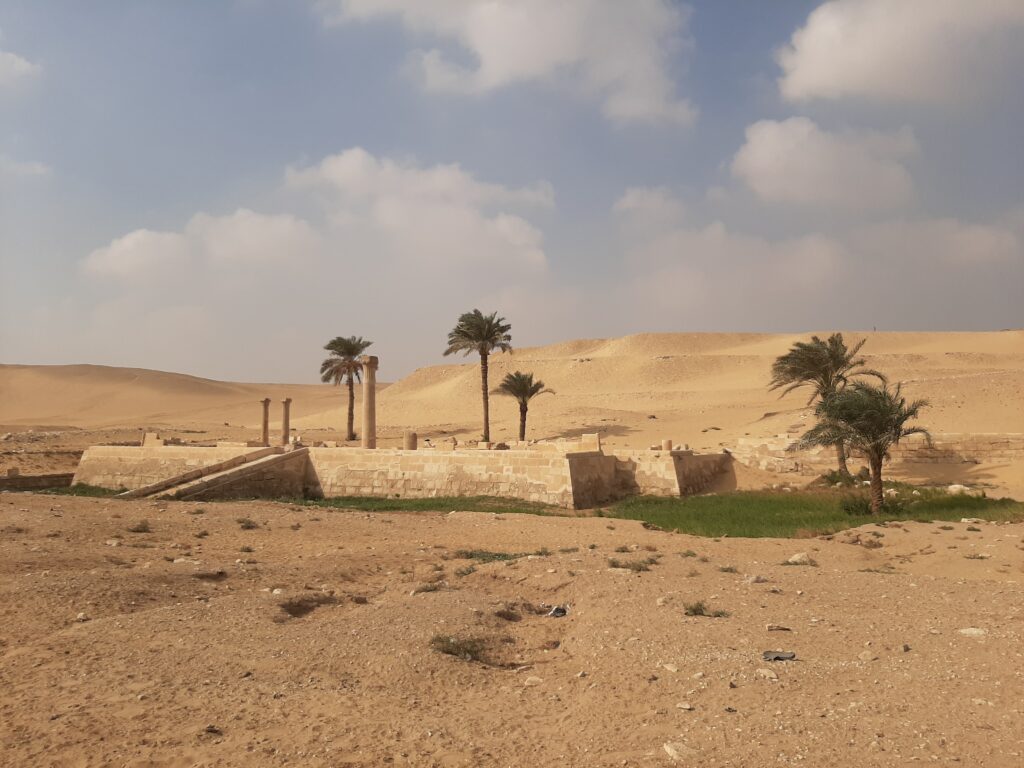
De daltempel van Unas, met kade (foto door de auteur)
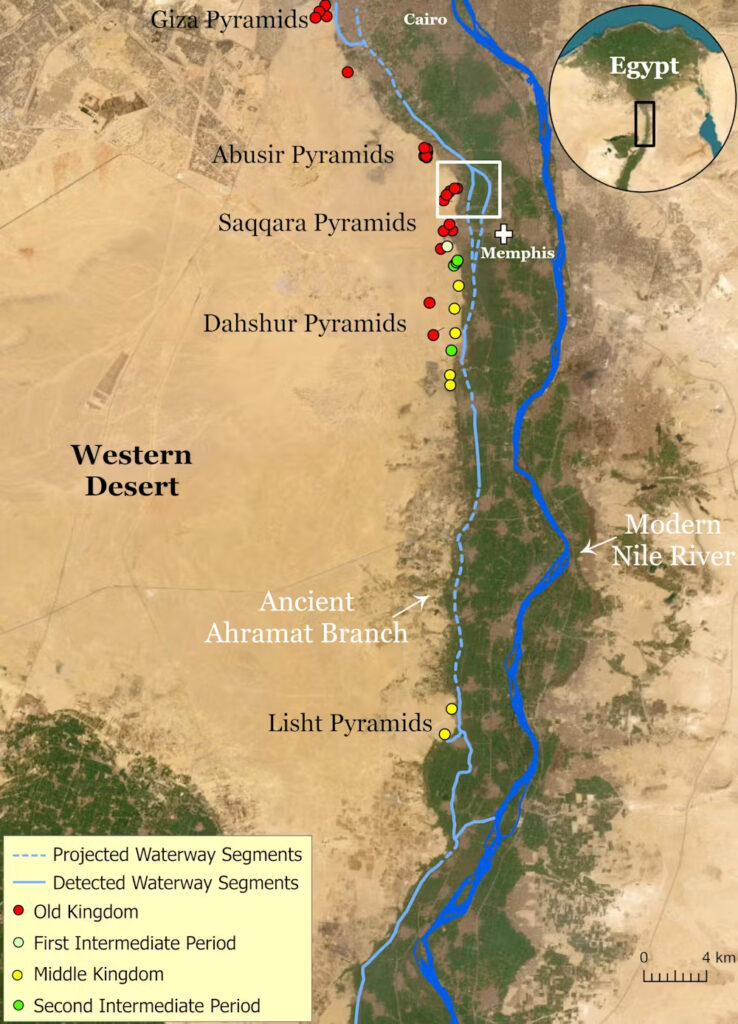
De Ahramat-tak uit het artikel van Ghoneim
De verdwenen Nijltak, die zich op 2,5 tot 10,25 km afstand van de moderne rivier bevindt, slibte na verloop van tijd dicht met zand en modder. Dit kan te maken hebben gehad met klimaatverandering en de langzame verwoestijning van de Sahara. We weten dat er aan het eind van het Oude Rijk (het tijdperk waarin de meeste en grootste piramides werden gebouwd) sprake was van droogte en wisselvallige Nijloverstromingen.
Op het bericht is gereageerd door o.a. de Egyptologen Francesco Tiradritti, Zahi Hawass en Mark Lehner. Tiradritti benadrukt dat de meeste blokken waaruit de piramides zijn opgetrokken lokaal werden gewonnen. De piramides van Giza staan als het ware in hun eigen steengroeve. De dekstenen van fijnere kalksteen kwamen vaak uit Tura, het rotsplateau aan de overkant van de Nijl, zo’n 25 km van Giza vandaan. Graniet (dat een deel vormde van Menkaure’s deklaag) kwam echter helemaal uit Aswan, 800 km verderop.
Ook zegt hij dat sporen van oude waterwegen niets nieuws zijn, maar dat de loop van de Nijl continu verschoof. De ontdekte Nijltak zou dan niets anders zijn dan de Nijl zelf. Wel draagt het onderzoek volgens hem veel bij aan onze kennis over het gebied.
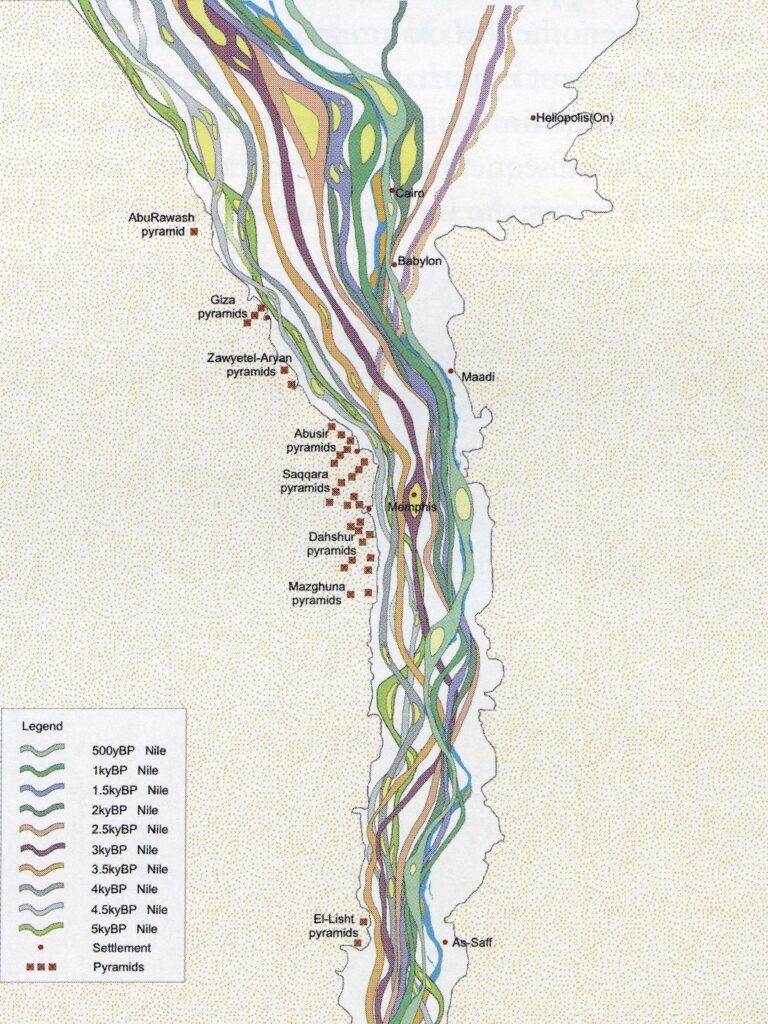
De Nijl verschoof nogal gedurende de geschiedenis (uit Lutley & Bunbury, Egyptian Archaeology 32, 2008)
Ook Zahi Hawass en Mark Lehner zeggen dat het artikel weinig nieuws biedt en dat het bestaan van een westelijke Nijltak (de Bahr el-Libeini) 50 jaar geleden al door George Goyon is voorgesteld. Het bestaan van havens bij dalwegen was al bekend. Tevens weten we sinds de ontdekking van de Wadi el-Jarf papyri in 2013, die het logboek bevatten van de inspecteur Merer, meer over de aanvoer van stenen naar de piramides.
Het gaat er dus niet om dat het onderzoek in Nature niet van belang is, maar dat je als wetenschapper netjes moet refereren naar eerder onderzoek.
Voor mijn eigen onderzoek is dit allemaal zeer interessant, omdat we zo een steeds beter beeld krijgen van de veranderlijkheid van het Egyptische landschap. We kunnen de scènes op de tombemuren, waarin weelderige moerassen en drukke savannes worden afgebeeld, daardoor beter duiden. Eind 2024 hoop ik klaar te zijn met mijn dissertatie over dit onderwerp.
-
Egyptologie tussen populariteit en wetenschap
Een vloek en een zegen van het doen van een PhD is veel vrijheid om je eigen tijd in te delen, maar daardoor ook denken dat daar meer van is dan je denkt. Zo dacht ik rond kerst eens even fijn twee boeken te lezen waaraan ik een minimale bijdrage had geleverd en die ik zeer vriendelijk kreeg toegestuurd: Farao Seti I door Dave Boots en Oudheidkunde is een wetenschap door Jona Lendering. Leuk voor onder de kerstboom.
Anders geschiedde, maar inmiddels heb ik tussen de bedrijven door tijd gevonden om beide boeken te lezen. Hier mijn ouderwetse boekbespreking/review.
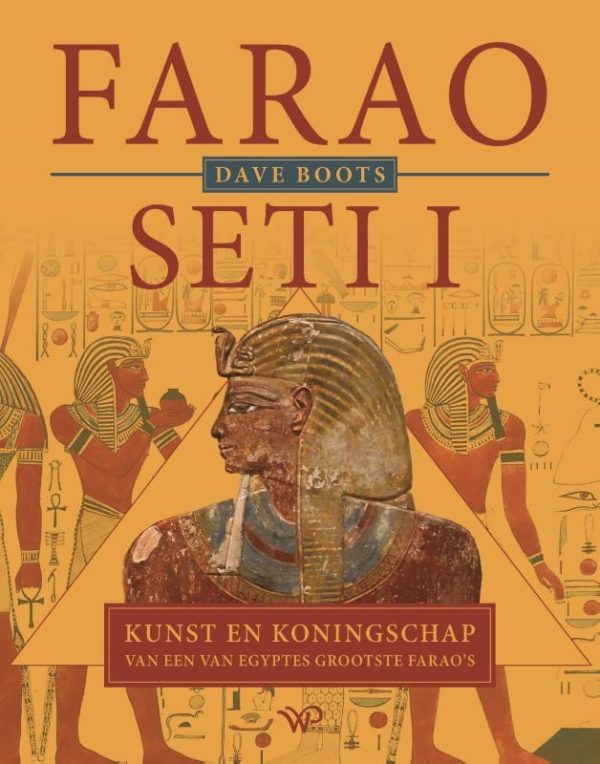
Farao Seti I
In Farao Seti I bespreekt Dave Boots (van Archeologie Magazine faam) de belangrijkste monumenten van deze farao uit het Nieuwe Rijk. Het mooi vormgegeven boek (leuk als cadeau!) werd uitgegeven bij Walburg Pers. Dave Boots presenteert zich in het dankwoord als leek, wat direct aansluit bij een uitspraak van Jona Lendering: dat er te weinig wordt geschreven voor het publiek door oudheidkundigen. Opvallend daarbij is dat Boots nog nooit in Egypte is geweest. De vraag rijst waar alle Egyptologen zich bevinden – mezelf inbegrepen – die ook een boek aan Seti hadden kunnen wijden. Overigens doen de Britten dat beter: er zijn twee Engelstalige boeken over de koning (Pharaoh Seti I door Nicky Nielsen uit 2018 en Sethy I door Aidan Dodson uit 2019).
In zeven hoofdstukken voert Boots ons langs de geschiedenis van het Nieuwe Rijk, het leven van Seti zelf, zijn beroemde zuilenhal in de Karnaktempel, de Osiristempel in Abydos, zijn prachtige graf in het Dal der Koningen, enkele andere monumenten, en zijn nalatenschap en de daaropvolgende Egyptomanie.
Soms leunt Boots daarbij te veel op (inmiddels achterhaalde) uitspraken gedaan door andere Egyptologen, zoals wanneer hij schrijft dat Hatsjepsoet haar militaire verantwoordelijkheden liet versloffen, terwijl de (mannelijke man) Amenhotep III een briljant diplomaat was. Achnaton wordt weggezet als dictator (maar geldt dit niet de facto voor alle Egyptische machthebbers?) en Tawosret zou gezorgd hebben voor chaos en burgeroorlog (aldus haar gepikeerde opvolger, ook weer een man). Boots heeft een fijne schrijfstijl, is soms wat informeel, en mag best wat kritischer zijn op de bronnen.
Het boek is meer beschrijvend dan interpreterend (daar hadden we nu net die Egyptoloog bij nodig), maar het is een handige gids voor iemand die de monumenten van Seti wil gaan bekijken. De tempelscènes van Abydos worden getypeerd als “zelfs voor Egyptologen moeilijk te doorgronden”, maar zie de publicatie van Rosalie David, Temple Ritual at Abydos (2016). Het klopt dat, om met Lendering te spreken, wetenschappelijke informatie vaak achter een betaalmuur zit, maar al deze boeken zijn gratis in te zien bij het Nederlands Instituut voor het Nabije Oosten in Leiden, en veel is inmiddels ook online als pdf te vinden.
Hoofdstuk 5 over het gecompliceerde graf van Seti in het Dal der Koningen (KV 17) bevat veel uitleg maar mist een aantal afbeeldingen van de belangrijkste scènes. De Egyptomanie besproken in hoofdstuk 7 blijft een leuk onderwerp want, geef toe, we zijn allemaal op een zeker moment aangetrokken geraakt tot het Oude Egypte of andere culturen uit de oudheid. Voor mij is dat te herleiden tot de film The Prince of Egypt (1998), de boeken van Christian Jacq (over Seti’s zoon Ramses ‘de Grote’) en een computerspel dat ik leende van mijn wiskundeleraar, waarbij mijn eerste actie was om in de put van Seti’s graf te vallen. Volledig nieuwe informatie voor mij was dat het Museum Catharijneconvent in Utrecht twee houten shabti’s bezit van Seti, die niet eens worden tentoongesteld! Het laatste hoofdstuk bestaat uit een aantal nuttige bijlages waarin de genoemde geografische namen, figuren uit Seti’s gevolg, en objecten van de koning in Nederlandse collecties worden opgesomd.
Enthousiasme voor de oudheid moet je nooit temperen, en Boots heeft als wetenschapscommunicator met zijn boek voor elkaar gekregen waar de paar Egyptologen-met-baan-in-het-vakgebied in Nederland helaas geen tijd voor hebben: een onderhoudend boek schrijven dat ook nog leuk staat op de koffietafel. Daarom alle lof voor hem!
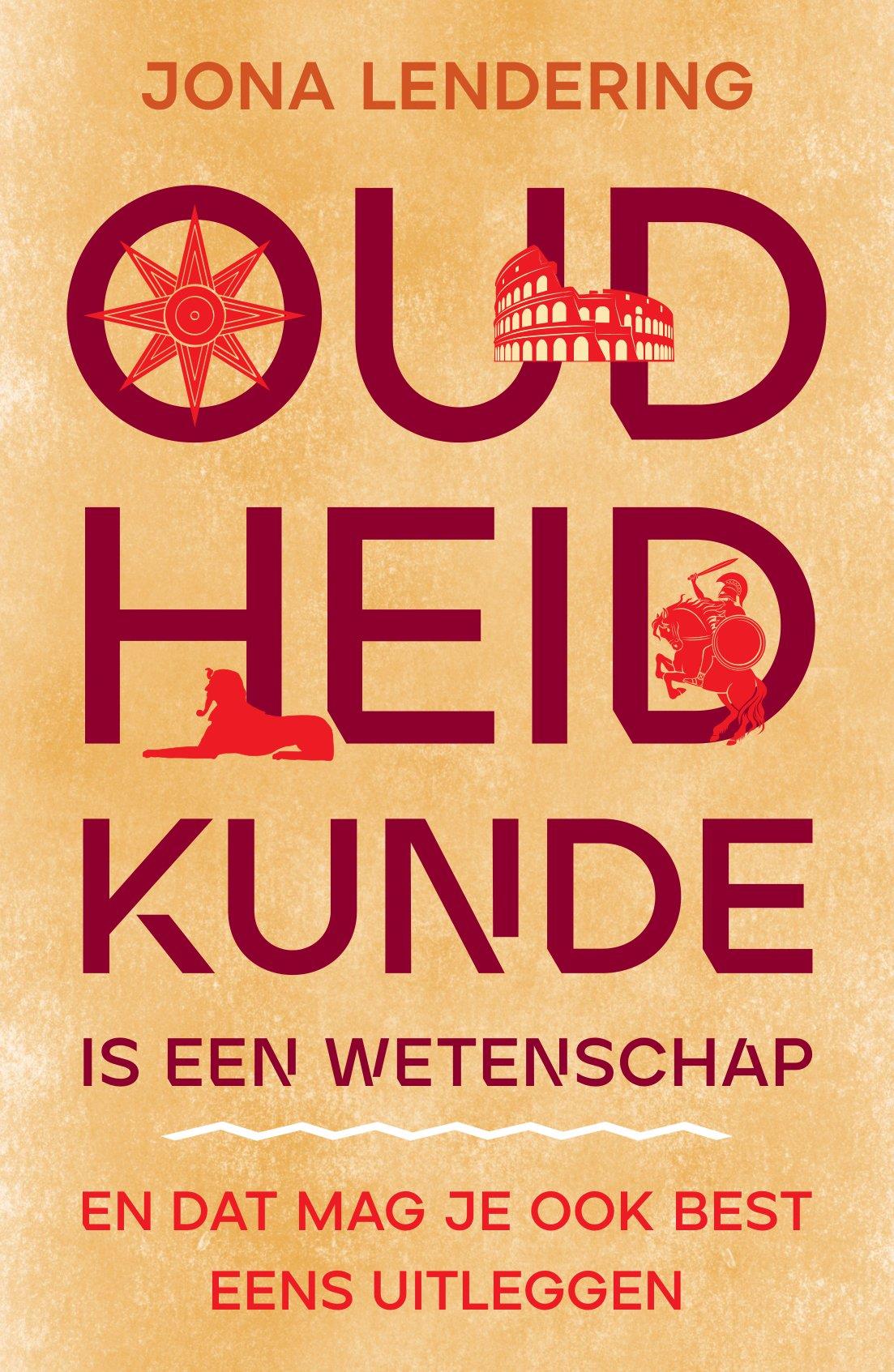
Oudheidkunde is een wetenschap
Dat brengt ons bij Jona Lendering, die een informatief boek schreef over de oudheidkunde als wetenschap. Al jarenlang stoort de blogger-historicus zich aan de in-de-oudheid-hadden-ze-ookjes (in de oudheid hadden ze ook migratie, klimaatverandering, bomen, noem het maar op) en de sensatiebeluste berichten over ‘schatten’, ‘mysteries’ en ‘verloren steden’ in de media. In dit boek legt hij daarom uit hoe dat eigenlijk werkt, dendrochronologie en isotopenonderzoek, maar ook hoe de huidige scheidslijnen tussen bijvoorbeeld archeologie en filologie, Egyptologie en Prehistorische archeologie zijn ontstaan.
In Duitsland, waar ik mijn PhD doe, zijn deze scheidslijnen misschien nog wel scherper en worstelt men net als in Nederland met het juist weer samenvoegen van diverse vakgebieden. Zo heette mijn master in Leiden ‘Classics and Ancient Near Eastern Civilisations’ en heeft men hier de studierichting ‘ALPHA’ opgericht: Archäologien und Philologien in den Altertumswissenschaften. Lendering pleit voor een langere studietijd, iets waar mijn oude supervisor ook vaak over mopperde. Ter illustratie: mijn bachelor en master besloegen samen vier jaar, maar heb ik weten te rekken door een tweejarige onderzoeksmaster en een tweede bachelor Archeologie te doen. Een geesteswetenschappen-PhD duurt in Duitsland echter maar drie jaar in plaats van vier jaar in Nederland. Een deadline die overigens met rasse schreden nadert.
Zelf probeer ik een brug te slaan tussen academische wetenschap en publiek middels deze website, maar zoals u ziet staan er lang niet zo veel artikelen op als ik zou willen. Ook heb ik niet altijd tijd om snel op het nieuws te reageren. Zo werd ik laatst gebeld door RTL over de Nijlarm die was ontdekt langs de piramides (reeds aangekondigd tijdens het Egyptologencongres in 2023), maar omdat ik niet in Nederland was kon ik niet op camera verschijnen. Ook vereist goede nieuwsduiding vaak het bestuderen van achtergrondinformatie, een tijdrovende bezigheid waar de media niet op zitten te wachten, en waar de PhD-student (die aan zijn/haar/diens dissertatie moet schrijven) geen tijd voor heeft. Laat staan een hoogleraar.
Is er dan geen hoop voor de oudheidkunde? Zeker wel, want er is zeer veel belangstelling bij het publiek voor de oudheid. Hierbij moet de onderzoeker die zich jarenlang wijdt aan een deelonderwerp en voorzichtige conclusies trekt echter opboksen tegen goedkope AI-onzin en de miljoenenbusiness van series als Ancient Apocalypse en, godbetert, Ancient Aliens. Zo werk ik al enkele jaren aan de database genoemd op blz. 118 van Lenderings boek maar heb nog steeds geen uitsluitsel over wanneer hartebeesten en nijlpaarden nou werkelijk uit het Egyptische straatbeeld verdwenen.
Er zijn natuurlijk ook leuke ontwikkelingen. Zo ben ik dol op data en biedt AI ook veel mogelijkheden. 3D-modellen die vrij makkelijk te maken zijn helpen iconografisch onderzoek op afstand. Foto’s van objecten in musea zijn steeds makkelijker online te vinden. En satellietbeelden/grondradar brengen verdwenen Nijlarmen in kaart, en kunnen plundering van archeologische vindplaatsen signaleren. Het is een klein beetje vechten tegen de bierkaai en liefdewerk oud papier, maar wie had gedacht toen ik mijn eerste boek over Egypte uit de bibliotheek haalde, dat ik me hier anno 2024 nog steeds mee zou bezighouden?
-
Oudegyptische moedergodinnen
In het Oude Egypte waren er diverse godinnen met een moederlijk aspect. Ze konden vriendelijk zijn en zorgzaam, maar ook vijanden verscheuren en de doden tot leven wekken. Ook namen ze verschillende vormen aan, van koeien, katten en gieren tot bomen en de nachtelijke hemel…
Isis werd ‘Moeder van de goden’ genoemd, en was met name de moeder van Horus, de valkgod die bij het verslaan van zijn boze oom Seth een oog verloor. Horus stond weer symbool voor de koning, een soort levende god op aarde. Ze had Horus trouwens verwekt toen haar man Osiris al een mummie was, in stukken gehakt door broer Seth en over het land verspreid. Er miste echter een onderdeel, u kunt wel raden wat. Gelukkig boetseerde Isis dit van Nijlklei, veranderde zichzelf in een vogel en wist alsnog de daad bij het woord te voegen. Daarna voedde ze Horus op in het geheim in het papyrusmoeras van de Nijldelta, waarna hij groot genoeg was om zijn oom te verslaan en koning te worden van Egypte. Denk ook aan Hamlet en the Lion King.

Isis in de vorm van een vogel. Haar naam staat geschreven met het troon-hiëroglief.
Hathor is één van de oudste Egyptische godinnen en werd vereerd in haar rol als moeder en koningin, maar ook als symbool van muziek, dans, liefde en seksualiteit. Ze was de dochter van Ra, de zonnegod, en werd vaak afgebeeld als koe of als dame met koeienoren. Ze is bijvoorbeeld te bewonderen in de prachtige Hathor-zuilen van de tempel van Dendera en in de Hathorkapel in de dodentempel van Hatsjepsoet in Deir el-Bahari. Eén van mijn allereerste vondsten als archeoloog in Saqqara was een scherf van een zogenaamde Hathorkruik met het gezicht van deze godin.

Een Hathorscherf doemt op in het woestijnzand…
Moet betekent letterlijk ‘moeder’. Ze werd gezien als de vrouw van de god Amon, en samen hadden ze een zoon, de maangod Khonsu. Gedrieën werd deze ’triade’ vereerd in de grote tempel van Karnak in Luxor. Daar had Moet ook een eigen tempel, te bereiken via een sfinxenlaan en omringd door een heilig U-vormig meer (een overblijfsel van het ‘moeras’ uit de tijd dat Karnak nog een eiland was). Leuk feit is dat deze tempel eind negentiende eeuw werd opgegraven door twee Britse dames, Margaret Benson en Janet Gourlay, iets wat vrij uitzonderlijk was voor die tijd. (De twee woonden samen en hadden een langdurige relatie). In het complex werden granodiorieten beelden gevonden van een leeuwengodin, wat ons brengt bij…

Beeld van Sachmet in het Moet-complex.
Sachmet vertegenwoordigt ongetwijfeld het meer agressieve karakter van het moederschap. Als een leeuwin die haar welpen beschermt, kon Sachmet flink huishouden. Het verhaal gaat dat Ra (als kwijlende, oude man) genoeg had van de mensheid en zijn dochter Hathor in de vorm van Sachmet (zo gaat dat met Egyptische goden) op pad stuurde om daar een eind aan te maken. Ze was echter zo bloeddorstig dat de goden spijt kregen en een list verzonnen om haar tot bedaren te brengen. Ze vulden een meer met bier, en kleurden het met rode oker. Sachmet zag het aan voor bloed en stortte zich op het meer. Ze werd daarbij zo dronken dat ze mak werd als een kat. En dat brengt ons bij…
Bastet was de andere kant van de medaille: het meer welgevallige en liefdevolle aspect van de godin. Waar Sachmet voor plagen en epidemieën kon zorgen bracht Bastet genezing met haar oliepot (het Oudegyptische woord ‘bas’). Haar meer huiselijke aard komt tot uiting als godin van zwangerschap en geboorte. Met het geluid van een sistrum (een soort metalen ratel) zouden priesteressen Sachmet kunnen kalmeren tot de rustigere variant Bastet. Ze had een eigen heiligdom in de stad Bubastis in de Nijldelta, waar de Griekse reiziger Herodotus in de 5e eeuw voor Chr. een festival meemaakte met veel Wein, Weib und Gesang.

In de Late Periode werd Bastet ook vereerd door middel van votiefgaven van… kattenmummies (© Reuters).
Veel Egyptische godinnen werden als beschermende moeder gezien. Zo ook Noet, de hemelgodin, die samen met Geb (de aarde) aan het begin stond van de scheppingsmythe van de noordelijke stad Heliopolis. Haar kinderen waren Osiris, Seth, Isis en Nephtys (zie de eerste paragraaf) en zo stond ze aan het begin van één van de belangrijkste godenfamilies. Als hemelgodin slokt ze elke avond de zonneschijf op, om deze weer te baren in de ochtend. Als een lichaam vol sterren spreidt ze zich uit over de wereld zoals te zien is in papyri, sarcofagen en op plafonds van koningsgraven. Ook is ze vaak te vinden in een sycomoorboom, waar ze zorgt voor koelte, en water en vruchten uitdeelt aan de overleden grafeigenaar en zijn vrouw.

Boomgodin in het graf van Pashesdu in Deir el-Medina. Dit kon Hathor voorstellen maar ook Noet.
Nechbet is al bekend uit predynastieke bronnen, dus nog voordat de ons bekende farao’s regeerden over een verenigd Egypte. Ze werd vereerd in de zuidelijke stad Necheb (het huidige Elkab) en had de vorm van een gier. Ze stond daarmee symbool voor het zuidelijke deel van de ‘Twee Landen’ (zoals Egypte werd genoemd), samen met Wadjet, de cobragodin van het noorden. In de Piramideteksten (hiërogliefenteksten in de koningsgraven uit het Oude Rijk) wordt ze ook wel als grote witte koe en moedergodin getypeerd (bv. PT 400). Als gier zweeft ze vaak boven het hoofd van de koning, en is te vinden boven tempelreliëfs en op grafplafonds. Een gierenpruik die verwijst naar Nechbet werd wel gedragen door godinnen als Hathor en koningin Nefertari.

Nechbet in een hoekje van de tempel van Hatsjepsoet in Deir el-Bahari.
Tot slot is er Taweret (Thoeris in het Grieks) die als dik nijlpaard met hangende borsten een duidelijke verwijzing is naar de zwangerschap (sorry, dames). Nijlpaarden zijn zeer beschermend tijdens de zoogtijd, en vallen dan gerust krokodillen aan, zoals te zien is in de Ouderijks privégraven. Beeldjes en amuletten van Taweret zijn wel gevonden in het dorp Deir el-Medina, waar de kunstenaars woonden samen met hun gezinnen die de graftombes in het Dal der Koningen versierden. Het is aan te nemen dat het sterftecijfer onder vrouwen in het kraambed en jonge kinderen hoog was, en daarom waren demonachtige beschermgoden (zoals ook de dwerggod Bes) van groot belang.

Faience beeldje van Taweret in het Metropolitan Museum.
